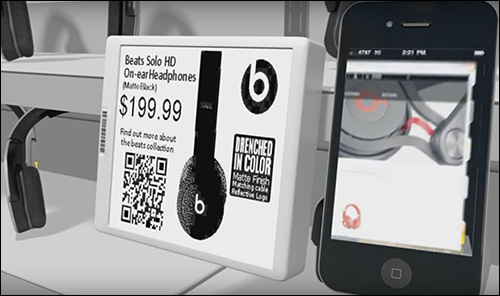Feb 16, 2016Displaydata has released an electronic shelf label (ESL), known as the Aura 29 BLE, that the company says will not only allow retailers to manage shelf pricing remotely, but also help them to deliver discount coupons and other promotional offers to shoppers based on their location, thanks to an integrated Bluetooth Low Energy (BLE) beacon.
The U.K.-based company says it is the largest supplier of fully graphic electronic shelf labels, which use electrophoretic display (EPD) technology to show information regarding a retailer's products. Each label receives updates to the information it will display via the company's Dynamic Communicator, according to Paul Milner, Displaydata's global marketing director.

Displaydata launched the Aura 29 BLE as a means of offering both ESL and beacon technologies built into a single product. "BLE is another way to start interacting with customers," Milner states.
A retailer using the Aura 29 BLE labels would, in most cases, integrate the BLE functionality into its own app. The retailer's customers would need to download that app on an Android or iOS smartphone or tablet, and have their device's Bluetooth radio turned on. The phone would then receive each electronic shelf label's "discovery signal," consisting of a unique ID number. Displaydata's content-management software, known as Dynamic Central, monitors the labels' battery levels, runs health checks, switches their beacons on and off, and performs other functions as well.
As a shopper moves around the store, his or her smartphone or tablet would receive the ID transmitted by each ESL beacon located in the aisles in which that person traverses. Based on the shopper's location, the app would then display product-related content, such as coupons, promotions, product information, reviews or suggestions about other foods or recipes that might work with that item.
In addition, an app could be used for wayfinding. Upon entering the store, a customer could input the product he or she seeks in the retailer's app, and would then be directed to that item based on the individual's location. (The retailer's own software would use the beacon technology to pinpoint where that shopper was located within the store.)
The BLE-enabled ESL could also prove useful to the retailer's personnel, who could log into their own employee-specific app for that store and view the shelves on which specific products are located. In this way, they could more easily accomplish restocking or inventory counts.
By using the ESL's BLE beacon function, Milner reports, stores could also track the movements of shoppers using the app, as well as ascertain how long they remained at a particular location. "The exciting piece is around the analytics and valuable customer insight the BLE-enabled ESL and the retailers app can capture," he says. The retailers' analytics software could display an image of the store's floor plan, with a heat map showing the locations of hot spots (high-traffic areas), based on where the system detected the greatest response from app-using phones, and for how long shoppers remained in those areas.
Using the Dynamic Central software, Milner explains, a retailer would be able to dial down a beacon's broadcast range, or the beacon could be turned off entirely if it was not needed at any specific time. He says he is unable to name any retailers that are using the Aura 29 BLE.
With or without beacon functionality, all Displaydata ESLs receive two-way RF signals transmitted by the Dynamic Communicator at a frequency below 1 GHz. The Communicators can be easily installed, requiring just a Power-over-Ethernet (PoE) connection. A single device can be used to manage as many as 65,000 labels within a 50,000-square-foot range. That means most stores require only a few Communicators. Displaydata's content-management software can be used to update pricing data for the labels, and then stores that information and forwards it to Communicators in the stores. In that way, a retailer with multiple stores could adjust pricing at all locations at once, or could select specific stores for the pricing changes.
The labels' content can be changed several times daily. The batteries in the labels are designed to last for one year if the labels are updated an average of five times per day.
Coop Denmark, which operates several retail chains throughout that nation, is using Displaydata ESLs without built-in BLE beacons at 180 of its stores as an alternative to paper labels. According to a case study written for Delfi Technologies (which provided its Breece software to drive media content displayed on labels), the store reported that the labels reduce the incidence of price errors resulting from paper labels, while also allowing for more frequent price changes and reduced labor costs, since—unlike paper labels—ESLs don't need to be replaced every time prices change. The ESLs also enable the stores to automatically reduce the prices of produce, such as fruits and vegetables, by 25 or 50 percent as those products near their expiration dates.
In addition, the Displaydata Dynamic Central software—which runs on a server located at a store or at a retailer's headquarters—enables stores to schedule price changes for specific days and times. For instance, a retailer could change its stores' prices while simultaneously updating the prices for those same products on its website.


